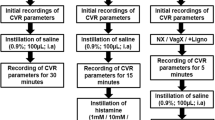Summary
The pharmacology of the early and delayed phases of the neurogenic oedema responses to electrical stimulation of the saphenous nerve was studied in anaesthetized rats using a quantitative Evans blue dye leakage technique. The immediate response to 5 min nerve stimulation was not reduced by aprotinin or mepyramine in combination with methysergide. However the response measured 10 min later and also that to 15 min nerve stimulation were reduced by these agents indicating that kinins and mast cell amines might be released after some delay, but they did not contribute significantly to the early phase of the response. Results with indomethacin indicated that prostaglandins were not involved in the later phase of the response.
Bacitracin which has been reported to potentiate the sialogogic effect of substance P, the most likely candidate for primary mediator of neurogenic oedema, was without effect on the early phase of the response. Morphine, which has been suggested to inhibit stimulus-evoked substance P release from primary afferent terminals, reduced the early phase of the neurogenic oedema response but it also reduced blood pressure. Both effects were abolished by naloxone and thus it is likely that the reduction in the neurogenic oedema response was due to the depressor action of morphine.
In confirmation of previous findings, capsaicin pretreatment of both adult rats and rats as neonates resulted in marked reduction of the neurogenic oedema response without effect on the vascular permeability response to substance P.
Similar content being viewed by others
References
Arvier PT, Chahl LA, Ladd RJ (1977) Modification by capsaicin and compound 48/80 of dye leakage induced by irritants in the rat. Br J Pharmacol 59:61–68
Chahl LA (1977) Interactions of substance P with putative mediators of inflammation and ATP. Eur J Pharmacol 44:45–49
Chahl JS, Chahl LA (1976) The role of prostaglandins in chemically induced inflammation. Br J Exp Path 57:689–695
Chahl LA, Ladd RJ (1976) Local oedema and general excitation of cutaneous sensory receptors produced by electrical stimulation of the saphenous nerve in the rat. Pain 2:25–34
Gamse R, Holzer P, Lembeck F (1980) Decrease of substance P in primary afferent neurones and impairment of neurogenic plasma extravasation by capsaicin. Br J Pharmacol 68:207–213
Garcia Leme J, Hamamura L (1974) Formation of a factor increasing vascular permeability during electrical stimulation of the saphenous nerve in rats. Br J Pharmacol 51:383–389
Harada M, Takeuchi M, Fukao T, Katagiri K (1971) A simple method for the quantitative extraction of dye extravasated into the skin. J Pharm Pharmacol 23:218–219
Hökfelt T, Kellerth J-O, Nilsson G, Pernow B (1975) Experimental immuno-histochemical studies on the localization and distribution of substance P in cat primary sensory neurons. Brain Res 100:235–252
Jancsó N, Jancsó-Gábor A, Szolcsányi J (1967) Direct evidence for neurogenic inflammation and its prevention by denervation and by pretreatment with capsaicin. Br J Pharmacol 31:138–151
Jancsó G, Kiraly E, Jancsó-Gábor A (1977) Pharmacologically induced selective degeneration of chemosensitive primary sensory neurones. Nature (Lond) 270:741–743
Jancsó-Gábor A, Szolcsányi J, Jancsó N (1970) Stimulation and desensitization of the hypothalamic heat-sensitive structures by capsaicin in rats. J Physiol (Lond) 208:449–459
Jessell TM, Iversen LL (1977) Opiate analgesics inhibit substance P release from rat trigeminal nucleus. Nature (Lond) 268:549–551
Jessell TM, Iversen LL, Cuello AC (1978) Capsaicin-induced depletion of substance P from primary sensory neurones. Brain Res 152:183–188
Kiernan JA (1977) A study of chemically induced acute inflammation in the skin of the rat. Quart J Exp Physiol 62:151–161
Lembeck F, Holzer P (1979) Substance P as neurogenic mediator of antidromic vasodilation and neurogenic plasma extravasation. Naunyn-Schmiedeberg's Arch Pharmacol 310:175–183
Lembeck F, Gamse R, Juan H (1977) Substance P and sensory nerve endings. In: von Euler US, Pernow B (eds) Substance P. Raven Press, New York, pp 169–181
Lembeck F, Holzer P, Schweditsch M, Gamse R (1978) Elimination of substance P from the circulation of the rat and its inhibition by bacitracin. Naunyn-Schmiedeberg's Arch Pharmacol 305:9–16
Olgart L, Gazelius B, Brodin E, Nilsson G (1977) Release of substance P-like immunoreactivity from the dental pulp. Acta Physiol Scand 101:510–512
Walker SB, Chahl LA (1980) The mechanism of enhancement of the neurogenic oedema response by baclofen. Eur J Pharmacol 62:27–34
Author information
Authors and Affiliations
Rights and permissions
About this article
Cite this article
Morton, C.R., Chahl, L.A. Pharmacology of the neurogenic oedema response to electrical stimulation of the saphenous nerve in the rat. Naunyn-Schmiedeberg's Arch. Pharmacol. 314, 271–276 (1980). https://doi.org/10.1007/BF00498549
Received:
Accepted:
Issue Date:
DOI: https://doi.org/10.1007/BF00498549




